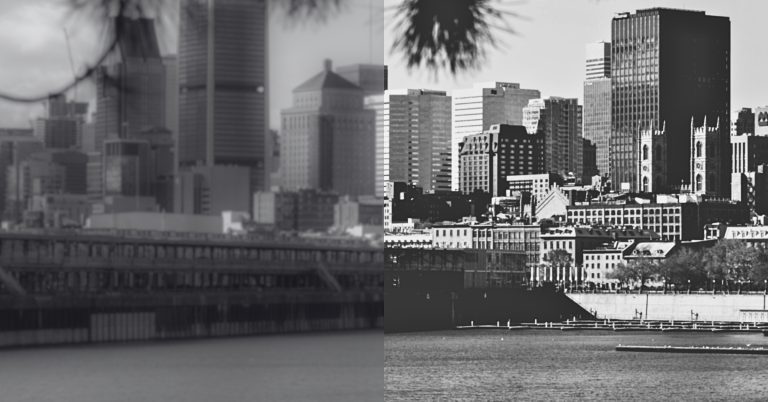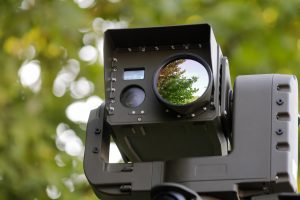Key Takeaways
- SWIR Camera Surveillance uses SWIR light to achieve superior SWIR imaging in conditions where visible light fails.
- SWIR light penetrates fog and smoke better than visible light, providing clearer images.
- SWIR imaging is unaffected by heat haze and atmospheric variations, ensuring consistent quality.
- SWIR cameras use sensors like InGaAs or MCT, often integrating with existing systems with minimal changes.
SWIR Camera Surveillance: Eliminating Haze
There’s a deep fog over everything, and you can’t see your hand when you hold it in front of you. The perfect night for a thief to sneak into your factories, make out with whatever they can carry, and get out the same way they came— or is it?
Not if you have SWIR camera surveillance. While visible light cannot penetrate well in water vapor, SWIR light has no problem that way. A SWIR camera can produce clear, high resolution images even when the human eye is unable to make heads or tails of anything. Here we’ll look at just what SWIR can do and how it does it.

The Foundations of SWIR Camera Surveillance
SWIR is short for short wave infrared and is the part of the spectrum with wavelength between 0.9 and 1.7 microns. Photons of SWIR light are absorbed and reflected from an object in a way analogous to visible light. It enables a high dynamic range and good contrast in imaging. But this light is invisible to the human eye, and the silicon sensors used for visible light imaging don’t work with SWIR. Dedicated SWIR sensors (typically made of InGaAs or MCT) are used instead.
SWIR lighting can illuminate an industrial complex at night while maintaining the appearance of darkness. Outdoors, natural SWIR (‘night glow’) is present under nearly all weather conditions, both day and night.

Why SWIR Camera Surveillance?
We’ve touched briefly on why short wave infrared SWIR camera surveillance is so important to a wide range of applications, but let’s look at it in more detail now. The importance of SWIR imaging lies in its wavelength. Since SWIR light has a shorter wavelength than visible light, it isn’t scattered by the microparticles of fog and smoke. This makes SWIR imaging more effective in such conditions compared to visible light. Heat haze and atmospheric temperature variances can cause havoc with thermal imaging. However, these factors do not affect SWIR imaging.
This makes SWIR imaging ideal for ensuring clear images at any time, whether it is night or morning. It also works effectively regardless of the atmospheric conditions.



Is that the only reason major players in industry, defense, and security are turning to SWIR camera surveillance? No, there are more.
One benefit of SWIR vision systems is that no visible illumination is needed. As mentioned in the last section, a powerful beam of SWIR light can illuminate a setting that looks dark to everyone using more traditional imaging equipment. A SWIR sensor can also be used to locate lasers and beacons, making it helpful in keeping track of mobile teams or for military IR laser spotting and tracking.
In biometrics, SWIR can be used to distinguish between fake hair and human hair. This enables easy identification of individuals who might be attempting to disguise their identity. Human hair will appear light, while fake hair shows up as dark. There’s nothing easier than picking out a person who is carrying around a head of hair that was manufactured in a factory.
SWIR Imaging Equipment
The InGaAs sensors used for SWIR imaging are manufactured from indium gallium arsenide. These sensors can detect light radiation ranging from 550nm to as high as 2.5μm. An alternative to InGaAs is MCT, or mercury-cadmium detector, which can detect into the long wave infrared LWIR region. The benefit of MCT is that it is ‘tunable’. The optical absorption wavelength changes based on the cadmium concentration. This allows the amount of cadmium (Cd) to be chosen to create a sensor that absorbs optimally in a given region. There is a big downside to MCT sensors, however— they must be cryogenically cooled.
SWIR radiation travels through glass in much the same way as visible light. This means that standard camera lenses, mirrors, and other optics can be used in short wave cameras. If you’d like to switch your existing surveillance system over to SWIR you may need to make only small modifications.

It may take less than you think to set up your new SWIR camera surveillance system.
Custom SWIR Camera Surveillance
At Avantier, we’re all about producing custom optics that enable our customers to reach their performance goals, no matter what the application. Whether you need a SWIR camera with high frame rates and low exposure time, a SWIR vision system for an unmanned vehicle, or SWIR imaging equipment for a research project, we can assist you. We provide the optical components and lens assemblies necessary for your specific needs. Just let us know your requirements, and we’ll tailor our solutions accordingly.
GREAT ARTICLE!
Share this article to gain insights from your connections!




